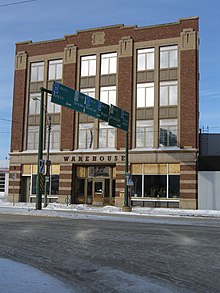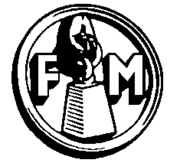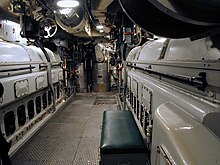Fairbanks, Morse and Company
Fairbanks, Morse and Company was an American company. It produced and sold a wide range of industrial products, mainly for farms, small and medium-sized businesses. The company also manufactured large diesel engines for ships and locomotives. It became known for its opposed piston diesel engines . Today diesel engine production is part of EnPro Industries .
history
Beginnings
In 1823, Thaddeus Fairbanks of St. Johnsbury began the commercial manufacture of the iron plow he had invented and a stove. The company founded together with his brother traded under the name "E&T Fairbanks & Company". In 1829, Fairbanks tried unsuccessfully to get into hemp fiber production. In June 1832 the platform scale he had invented was patented. Just a generation later, the scales were sold in the United States, Europe, South America and China. The increasing volume of goods being transported over water and by rail ensured good sales of the scales, as they were needed to determine transport charges. To make sales more efficient, largely independent branches were opened across the country. In 1850 Charles Hosmer Morse began working for one of these offices in Cincinnati. In 1870 he moved to Chicago and opened his own branch there. After the Great Chicago Fire in 1871, the branch operated under the name "Fairbanks, Morse & Company".
In 1880 Morse took a 20% stake in the "Eclipse Wind Engine Company". This company was founded by Leonard H. Wheeler to manufacture the Eclipse wind turbines he invented in Beloit (Wisconsin) in 1867 . The wind turbines were used to operate water pumps and were a sales success on farms in the western United States and Australia. From now on, the wind turbines were sold through “Fairbanks & Co.”.

With the takeover of the wind turbines, Fairbanks & Co.'s product range was further expanded and territorial expansion was also made possible. This expansion of the business initiated by Morse led to his becoming a corporate partner at "Fairbanks & Co" in 1885. As a result, Morse took over the "Eclipse Wind Engine Company" completely and merged it with "Williams Engine Works" to form "Fairbanks, Morse & Company". In 1906 Morse acquired the manufacturer of electric motors and generators "Three Rivers Electric Co.". In 1915 Morse also took control of the scale manufacturer "Fairbanks Scales" and in 1926 the individual companies were merged and the brand name was changed to "Fairbanks-Morse".
The company's expansion continued from the end of the 19th century. The catalog offered a wide variety of items, including hand presses, typewriters, handcarts, rail bicycles, pumps, tractors and other machines for transporting stored and bulk goods. The company became a supplier of complete pumping systems with tools, fittings, seals, valves and pipes. Around 1908 experiments were also carried out with automobile construction. A single prototype with a four-cylinder engine was created. The design may have been based on designs by the Buda Engine Co. in Buda, Illinois . In addition, trucks with 3 tons were produced for a short time .
In 1910, the catalog had 800 pages. In the period that followed, Fairbanks-Morse tried to manufacture railway cranes, televisions, radios and refrigerators in addition to the manufacture of engines, but was unable to achieve any significant sales.
Diesel engine production

Engine production began as early as 1890. At first it was steam and gasoline engines . The farmers used the machines for irrigation and electricity generation and thus often replaced the wind turbines. They were also used in oil production. The small power generators for lighting were particularly popular. From 1893 kerosene engines were offered, from 1905 coal gas engines and from 1913 glow-head engines .
The “Z” engine, offered from 1916 onwards, was offered with an output of one, three and six hp. Over half a million of these engines were produced in the next 30 years, mostly bought by farmers.
In 1912, Fairbanks-Morse began developing and manufacturing diesel engines. First, the hot-head motor model "Y" was offered in variants with one to six cylinders and an output of 25 to 200 hp. The engine was used as a power station in many companies. This engine was followed in 1924 by the “YLA” model. This was the first diesel engine developed by Fairbanks-Morse that did not rely on any foreign patents, had a high compression ratio and was suitable for cold starts. "CO" for ship propulsion and "E" as a further developed version of the "Y" model followed as further models. Based on these engines, Fairbanks-Morse developed power stations for railways and ships. With the development of diesel locomotives and motor ships in the 1930s, the company began to expand further.
In 1932 the opposed piston diesel engine developed by FP Grutzner was presented. During the Second World War, the entire engine production of Fairbanks-Morse was used to build submarine drives. Around 50% of the US Navy 's submarine fleet owned Fairbanks-Morse engines. Even today, Fairbanks-Morse diesel engines are used as a drive unit or generator in ships of the US Navy.
Diesel locomotives
The first engine suitable for railway operations was a 300 hp machine. This was used in test railcars for the Baltimore and Ohio Railroad and Milwaukee Road . A shunting locomotive for the Reading Company and one for its own works also received the engine.
In 1939 the St. Louis Car Company installed the 800 hp 38D8 engine in six streamlined railcars for the Southern Railway . These were designated as FM OP 800 . A further development was not possible due to the production restrictions during the Second World War . It was not until 1944 that Fairbanks could begin production of the FM H-10-44 shunting locomotives . Frames and bogies from Baldwin and General Steel Castings Co. were used for the construction, and the electrical equipment from Westinghouse was used. The vehicle design was entrusted to the industrial designer Raymond Loewy . Since Milwaukee Road served the Beloit locomotive plant, the company became Fairbanks-Morse's best customer, and they also bought the first locomotive.
In 1945, FM launched its competing product for the EMD F series and ALCO PA . The 2000 hp locomotives with the axle arrangement (A1A) (A1A) were manufactured by General Electric in Erie (Pennsylvania) because there was not enough space at FM. For this reason the locomotives are also called " Erie built ". The design of the vehicle shell was again done by Raymond Loewy. The locomotives were not very successful; By 1949, 82 units with and 29 without a driver's cab were built.
The following series of locomotives were then manufactured in the company's own factory in Beloit. From January 1950 the "C-Liner" (Consolidated line) was produced. The first customers were the New York Central Railroad , the Pennsylvania Railroad and the Milwaukee Road . The Canadian Locomotive Company in Kingston (Ontario) built the license in Canada for the Canadian Pacific and the Canadian National . Due to frequent technical problems and poor factory support, the series was not a success. The Westinghouse generators in particular were often susceptible to damage. The engines also showed a significantly shorter piston life than when used in submarines. In addition, the opposed piston design made maintenance of the engines much more difficult. 99 locomotives of the C-Liners were built. Another 66 units were produced at CLC for the Canadian railways. In 1953 Westinghouse announced, also influenced by the problems with the generators, to leave the locomotive supply market. As a result, Fairbanks-Morse felt compelled to give up the production of the C-Liners, since switching to another supplier would have been too costly. In addition, the railway companies now preferred the road switcher design, as offered by EMD with the GP7 .
The successor model were the Train Master locomotives . These were the strongest of their time in terms of performance. The locomotives were universally applicable and were purchased by ten railway companies. Compared to EMD and ALCO , Fairbanks-Morse was unable to achieve sufficient market shares. As a result of the completed conversion of the railway companies' fleet of locomotives to diesel engines, new orders also fell sharply. So it was finally decided in 1958 to give up uneconomical production for the US market. In 1963 the last locomotives were delivered to Mexico. The Canadian Locomotive Company continued to produce until 1969. A total of 1460 locomotives were manufactured by Fairbanks-Morse for 49 customers.
Corporate merger
In addition to the construction of diesel locomotives, the production of diesel and gas engines was continued. Production facilities were opened in Mexico and Canada. Global expansion continued with the opening of sales offices in Rio de Janeiro and Buenos Aires. The previous sales office in Australia (Cooper Sheep Shearing Machinery Ltd.) developed into its own production facility.
The production of wind-powered pumps was sold. The electrification of the country, which began in the 1940s, also made the operation of small and medium-sized self-sufficient power generators uneconomical and costly. However, the sale of larger power generation systems was continued.
What began in the late 1930s with a dispute between the sons of Charles Morse, Jr., Charles Hosmer Morse, Jr. and Robert H. Morse, over control of Fairbanks-Morse, ended in 1958 with the takeover by the corporate conglomerate Penn-Texas Corporation and the name change to Fairbanks-Whitney. In the years that followed, the market shares for Fairbanks-Morse products continued to decline. The previous sales strategy of offering everything from a single source for the farms and businesses was no longer accepted. In 1964 the name was again changed to Colt Industries . In the 1980s, the production of electric generators, pumps and scales were sold. After the arms production was outsourced, the group renamed itself Coltec Industries. In 1999 Coltec was taken over by BF Goodrich . In 2002, the specialty chemicals and diesel engine divisions were spun off into EnPro Industries .
Todays situation
Under the name Fairbanks Morse Engine , EnPro now offers a wide range of diesel engines and generator units for stationary use and use on ships. In addition to the manufacture of opposed piston engines under the name Fairbanks-Morse, MAN engines are manufactured under license under the names FM / MAN and Colt-Pielstick . The company also owns the rights to the ALCO 251 locomotive diesel engine. Production continues at the Beloit site.
Fairbanks Scales , founded in 1988 through a management buy-out , manufactures all types of scales .
Minnesota-based Pentair manufactured pumps under the Fairbanks Morse brand . In 2012 the brand was merged with the company's second pump brand to form “Fairbanks Nijhuis”.
literature
- Jerry a. Pinkepank: Born at Beloit, the Cinderella of Dieseldom: Fairbanks_Morse . In: Trains . Kalmbach Publishing Co., November 1964, ISSN 0041-0934 , p. 36-49 .
- Steve Glischinski: Fairbanks, Morse & Co. In: William D. Middleton, George M. Smerk, Roberta L. Diehl (Eds.): Encyclopedia of North American Railroads . Indiana University Press, Bloomington, IN 2007, ISBN 978-0-253-34916-3 .
- Louis A. Marre: Diesel Locomotives: The First 50 Years . Kalmbach Publishing Co., Waukesha, WI 1995, ISBN 0-89024-258-5 .
- Beverly Rae Kimes (Editor), Henry Austin Clark Jr.: Standard Catalog of American Cars 1805–1942. 3. Edition. Krause Publications, Iola WI (1996), ISBN 978-0-87341-428-9 ISBN 0-87341-428-4 . (English)
Web links
Individual evidence
- ↑ a b Kimes (1996), p. 555
- ↑ Find a grave: Charles Hosmer Morse, Jr
- ↑ worldpumps.com Pentair creates Fairbanks Nijhuis




